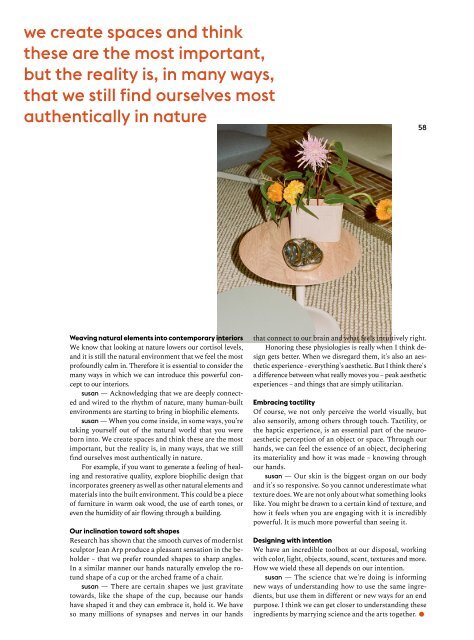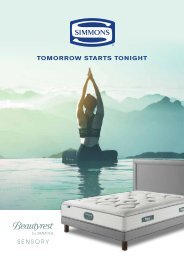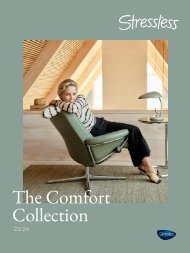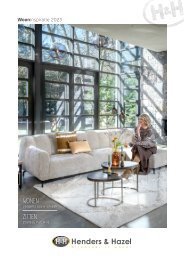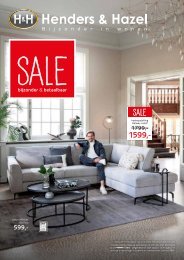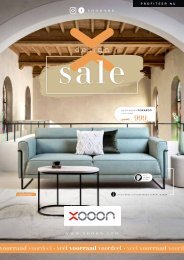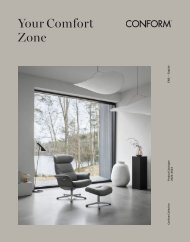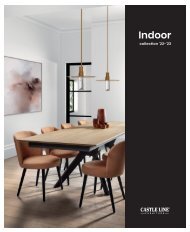Muuto_Catalog_2022
You also want an ePaper? Increase the reach of your titles
YUMPU automatically turns print PDFs into web optimized ePapers that Google loves.
we create spaces and think<br />
these are the most important,<br />
but the reality is, in many ways,<br />
that we still find ourselves most<br />
authentically in nature<br />
58<br />
Weaving natural elements into contemporary interiors<br />
We know that looking at nature lowers our cortisol levels,<br />
and it is still the natural environment that we feel the most<br />
profoundly calm in. Therefore it is essential to consider the<br />
many ways in which we can introduce this powerful concept<br />
to our interiors.<br />
susan — Acknowledging that we are deeply connected<br />
and wired to the rhythm of nature, many human-built<br />
environments are starting to bring in biophilic elements.<br />
susan — When you come inside, in some ways, you’re<br />
taking yourself out of the natural world that you were<br />
born into. We create spaces and think these are the most<br />
important, but the reality is, in many ways, that we still<br />
find ourselves most authentically in nature.<br />
For example, if you want to generate a feeling of healing<br />
and restorative quality, explore biophilic design that<br />
incorporates greenery as well as other natural elements and<br />
materials into the built environment. This could be a piece<br />
of furniture in warm oak wood, the use of earth tones, or<br />
even the humidity of air flowing through a building.<br />
Our inclination toward soft shapes<br />
Research has shown that the smooth curves of modernist<br />
sculptor Jean Arp produce a pleasant sensation in the beholder<br />
– that we prefer rounded shapes to sharp angles.<br />
In a similar manner our hands naturally envelop the rotund<br />
shape of a cup or the arched frame of a chair.<br />
susan — There are certain shapes we just gravitate<br />
towards, like the shape of the cup, because our hands<br />
have shaped it and they can embrace it, hold it. We have<br />
so many millions of synapses and nerves in our hands<br />
that connect to our brain and what feels intuitively right.<br />
Honoring these physiologies is really when I think design<br />
gets better. When we disregard them, it's also an aesthetic<br />
experience - everything's aesthetic. But I think there's<br />
a difference between what really moves you – peak aesthetic<br />
experiences – and things that are simply utilitarian.<br />
Embracing tactility<br />
Of course, we not only perceive the world visually, but<br />
also sensorily, among others through touch. Tactility, or<br />
the haptic experience, is an essential part of the neuroaesthetic<br />
perception of an object or space. Through our<br />
hands, we can feel the essence of an object, deciphering<br />
its materiality and how it was made – knowing through<br />
our hands.<br />
susan — Our skin is the biggest organ on our body<br />
and it's so responsive. So you cannot underestimate what<br />
texture does. We are not only about what something looks<br />
like. You might be drawn to a certain kind of texture, and<br />
how it feels when you are engaging with it is incredibly<br />
powerful. It is much more powerful than seeing it.<br />
Designing with intention<br />
We have an incredible toolbox at our disposal, working<br />
with color, light, objects, sound, scent, textures and more.<br />
How we wield these all depends on our intention.<br />
susan — The science that we're doing is informing<br />
new ways of understanding how to use the same ingredients,<br />
but use them in different or new ways for an end<br />
purpose. I think we can get closer to understanding these<br />
ingredients by marrying science and the arts together.•


